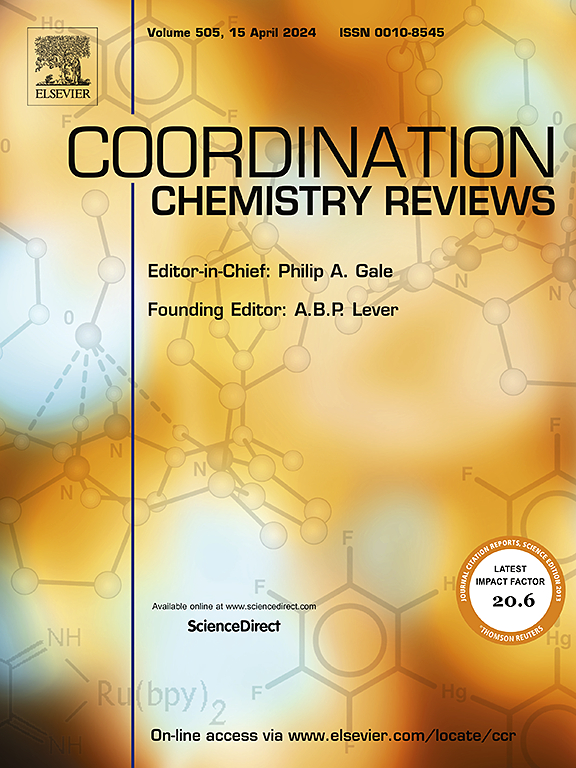硝酸电化学还原制氨的最新趋势与展望,重点是钴催化剂
IF 20.3
1区 化学
Q1 CHEMISTRY, INORGANIC & NUCLEAR
引用次数: 0
摘要
由于其高能量密度,易于液化,以及现有的强大的生产和分销基础设施,特别是在农业部门,氨作为一种有前途的能源载体正在获得认可。在环境条件下进行的电化学硝酸还原反应(NO3RR)为能源密集型的Haber-Bosch (HB)工艺提供了一种可持续的替代方案,解决了环境和能源挑战。近年来在了解催化机理、优化催化系统和设计先进催化剂方面取得的进展大大提高了硝酸盐转化为氨的效率。其中,钴基电催化剂因其丰富的稀土元素、低廉的成本和良好的催化性能而成为一种经济高效的贵金属替代品。本文综述了NO3RR的最新研究进展,重点介绍了co基电催化剂。它深入研究了NO3RR机理分析,系统优化的关键考虑因素,以及创新的co基催化剂设计策略。此外,我们还探讨了当前面临的挑战,并提出了提高co基电催化剂性能的未来方向,旨在推动合理设计高效的可持续合成氨催化剂。本文章由计算机程序翻译,如有差异,请以英文原文为准。

Recent trends and prospects in electrochemical nitrate reduction to ammonia with an emphasis on cobalt catalysts
Ammonia is gaining recognition as a promising energy carrier due to its high energy density, ease of liquefaction, and existing robust production and distribution infrastructure, particularly within the agricultural sector. The electrochemical nitrate reduction reaction (NO3RR), conducted under ambient conditions, offers a sustainable alternative to the energy-intensive Haber–Bosch (H![]() B) process, addressing both environmental and energy challenges. Recent advancements in understanding catalytic mechanisms, optimizing catalytic systems, and designing advanced catalysts have substantially enhanced the efficiency of nitrate-to-ammonia conversion. Among these, cobalt (Co)-based electrocatalysts have emerged as a cost-effective and efficient alternative to noble metals, owing to their earth abundance, low cost, and favorable catalytic properties. This review provides a comprehensive overview of recent progress in NO3RR, emphasizing Co-based electrocatalysts. It delves into NO3RR mechanism analysis, critical considerations for system optimization, and innovative Co-based catalyst design strategies. Additionally, we explore current challenges and propose future directions for improving Co-based electrocatalyst performance, aiming to advance the rational design of efficient catalysts for sustainable ammonia synthesis.
B) process, addressing both environmental and energy challenges. Recent advancements in understanding catalytic mechanisms, optimizing catalytic systems, and designing advanced catalysts have substantially enhanced the efficiency of nitrate-to-ammonia conversion. Among these, cobalt (Co)-based electrocatalysts have emerged as a cost-effective and efficient alternative to noble metals, owing to their earth abundance, low cost, and favorable catalytic properties. This review provides a comprehensive overview of recent progress in NO3RR, emphasizing Co-based electrocatalysts. It delves into NO3RR mechanism analysis, critical considerations for system optimization, and innovative Co-based catalyst design strategies. Additionally, we explore current challenges and propose future directions for improving Co-based electrocatalyst performance, aiming to advance the rational design of efficient catalysts for sustainable ammonia synthesis.
求助全文
通过发布文献求助,成功后即可免费获取论文全文。
去求助
来源期刊

Coordination Chemistry Reviews
化学-无机化学与核化学
CiteScore
34.30
自引率
5.30%
发文量
457
审稿时长
54 days
期刊介绍:
Coordination Chemistry Reviews offers rapid publication of review articles on current and significant topics in coordination chemistry, encompassing organometallic, supramolecular, theoretical, and bioinorganic chemistry. It also covers catalysis, materials chemistry, and metal-organic frameworks from a coordination chemistry perspective. Reviews summarize recent developments or discuss specific techniques, welcoming contributions from both established and emerging researchers.
The journal releases special issues on timely subjects, including those featuring contributions from specific regions or conferences. Occasional full-length book articles are also featured. Additionally, special volumes cover annual reviews of main group chemistry, transition metal group chemistry, and organometallic chemistry. These comprehensive reviews are vital resources for those engaged in coordination chemistry, further establishing Coordination Chemistry Reviews as a hub for insightful surveys in inorganic and physical inorganic chemistry.
 求助内容:
求助内容: 应助结果提醒方式:
应助结果提醒方式:


